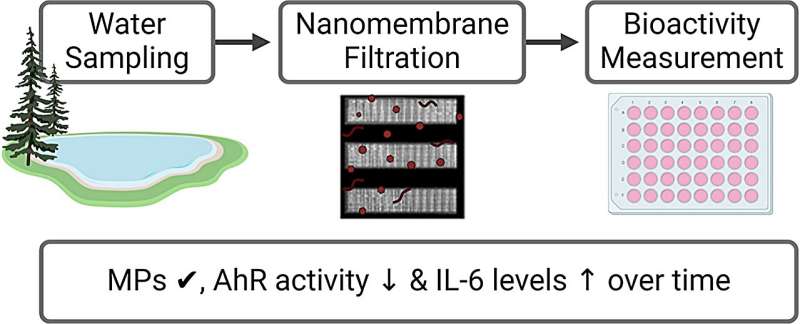This article has been reviewed according to Science X's editorial process and policies. Editors have highlighted the following attributes while ensuring the content's credibility:
fact-checked
proofread
Sizing up microplastics: Nanofiltration uncovers environmental bioactivity

A new study reveals the bioactivity of microplastics in Lake Ontario using cutting-edge nanomembrane filtering technology. Researchers found all samples contained microplastics ranging between 8 and 20 µm. The study is published in the journal Eco-Environment & Health.
The study highlights varying bioactivity levels, such as aryl hydrocarbon receptor (AhR) activity and IL-6 levels, indicating potential health risks. These findings underscore the urgent need for further research to comprehend the impact of microplastics on human health and the environment. This pioneering approach offers fresh insights into tackling the challenges posed by microplastic pollution.
Microplastics are a significant pollutant present in ecosystems worldwide, including oceans, lakes, and rivers. These particles pose potential health risks due to their persistence and complex composition, which includes various toxic chemicals.
Prior research has highlighted the widespread presence of microplastics and their potential impact on human health. Based on these challenges, it is crucial to conduct in-depth studies on the bioactivity of microplastics in environmental samples to assess their health risks.
The new study utilized innovative nanomembrane filtering technology to isolate and analyze microplastic-containing debris from Lake Ontario. Researchers collected samples from four locations at different times, using silicon nitride nanomembrane filters to isolate debris between 8 and 20 µm.
Nile Red staining confirmed the presence of microplastics in all samples. Cell-based assays assessed cell viability, AhR activity, and IL-6 levels, revealing that while microplastics were consistently present, their bioactivity varied over time.
The isolated debris showed no impact on cell viability, indicating a lack of cytotoxicity. However, variations in AhR activity and IL-6 levels suggest that the bioactivity of microplastics depends on their physicochemical properties. The study emphasizes the need for more extensive sampling to fully characterize microplastic bioactivity and understand the influence of sample properties.
Dr. Sarah E. Morgan, lead researcher, stated, "Our findings demonstrate the potential health risks posed by microplastics in Lake Ontario. The variability in bioactivity observed highlights the importance of understanding the physicochemical properties of these particles.
"This study underscores the need for more extensive sampling and analysis to fully assess the health implications of microplastic exposure. The novel nanomembrane filtering technology we employed offers a promising approach for future research in this field."
The implications of this research are far-reaching, offering a new methodology for environmental monitoring and health risk assessment. By enhancing our ability to detect and analyze microplastics, the study paves the way for more targeted strategies to mitigate plastic pollution and protect aquatic ecosystems.
Moreover, the insights gained could inform regulatory measures and public health policies aimed at reducing exposure to these pervasive contaminants.
More information: Sarah E. Morgan et al, Assessing bioactivity of environmental water samples filtered using nanomembrane technology and mammalian cell lines, Eco-Environment & Health (2024). DOI: 10.1016/j.eehl.2024.05.004
Provided by Nanjing Institute of Environmental Sciences



















